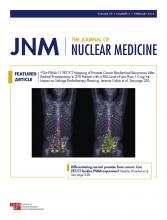REPLY: In our recently published article, we describe the performance of a new tracer, 18F-GP1, in a well-established extracorporeal human blood circuit and in a nonhuman primate model (1). We are fully aware of limitations imposed by any model and would like to point to a phase 1 clinical study that is currently ongoing to investigate 18F-GP1 in subjects with acute symptoms of deep vein thrombosis and pulmonary embolism (NCT02864810). Preliminary interim data from this study that were presented recently at the SNMMI 2017 annual meeting confirm the preclinical data on 18F-GP1 biodistribution and its ability to image thrombi in humans (2). Of note, thromboembolic foci have been successfully detected in all patients enrolled with acute pulmonary embolism and deep vein thrombosis so far, and the coincident occurrence of deep vein thrombosis and pulmonary embolism was common, as would be expected. Although the clinical study results are preliminary and a manuscript has not yet been peer-reviewed, they show that 18F-GP1 behaves analogously in humans and nonhuman primates. We can only surmise that there are enough activated platelets in venous clots to generate a robust signal given the high affinity and selectivity of the tracer.
Dr. Alavi et al. reported on the potential use of 18F-FDG in the assessment of deep vein thrombosis if the results from a small study are confirmed in a larger prospective trial (3). However, we have doubts of the general utility of 18F-FDG in clinical routine. Because 18F-FDG visualizes only thrombus-associated inflammation, it can be only a surrogate marker of thrombosis. 18F-FDG uptake is not representing a critical mechanism in clot formation. We believe that accurate detection of the thrombus itself, without the associated inflammatory processes, is critical to a successful thrombus tracer. Nonspecificity may limit the use of 18F-FDG, particularly with regard to monitoring of targeted pharmacologic intervention. In contrast, the ability to track activated platelets by a specific targeted PET probe would allow antithrombotic therapies to be optimized through titration of antithrombotic and antiplatelet agents.
Many nuclear medicine tracers over the years have not performed adequately in the detection of pulmonary emboli. The inability of a tracer to access the emboli, the small size of the emboli, or the loss of the tracer target from the emboli are possible reasons. It is hoped that in the future a tracer that is well characterized and validated will be able to help address these possibilities.
Although there is still much to learn about 18F-GP1, the discussed preclinical article, bolstered by early clinical data, indicates that 18F-GP1 is a promising tracer, especially with respect to the high signal-to-noise ratio and the high specificity for GPIIb/IIIa on platelets over the many other integrins involved in inflammation and endothelial activation. We eagerly await additional clinical data.
Footnotes
Published online Oct. 30, 2017.
- © 2018 by the Society of Nuclear Medicine and Molecular Imaging.







